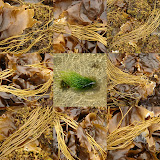


13.04.07
After the leisurely bus-trip yesterday we took to the moor for a 4 1/2 hours walk today. Starting at the wooden footbridge not far from the Geisiadar road-end we followed the markers uphill over flat rock slabs and broken peat bogs until we reached Loch a’ Phealuir where we used to fish for trout. It is actually two Lochs with a narrow isthmus between them which can be easily crossed over on a path of slabs. We followed a sheeptrack over the hill Orchleit which took us to the large Loch Grunabhat, another good brown trout loch. Around the loch a sheeptrack with markers is supposed to guide you to a green mossy patch with a „bodh“ or beehive dwelling. Unfortunately the markers here are no longer to make out clearly, so last time we were unable to find it. The „bodh“ is not visible from the path and you only recognize it, when you are actually there. We were more lucky this time and after crawling through a low and narrow entrance much to our surprise we could even stand upright and marvel at the ancient building with many shelves and a flatstone-floor- the best preserved bodh I have seen. Nearby there are remains of shielings, larger stone buildings with turf-roofs for the milkmaids who tended the cattle during the summermonths on a pasture in the moor while the crops on the fields of the village were growing. Although wet and boggy in places it was not any more difficult to walk than in summer. This shows how well the terrain trains if you think of the huge pools everywhere a forthnight ago due to the heavy rainfall during winter. There was no grass or heather growing yet but also no sign of midges...
Nach dem gemütlichen Ausflug gestern unternahmen wir heute eine 4 1/2 Stunden Wanderung durch das Moor. An forellenreichen Seen vorbei, geleitet durch Markierungsteine ging es durch teilweise moorig-feuchtes Gebiet bis zum “Bodh Mileabhat”, das man allerdings erst sieht, wenn man davorsteht...Dieses bienenkorbförmige altertümliche Gebäude ist sehr gut erhalten. Einer der beiden tiefliegenden sehr engen Eingänge ist geblockt, Im Innern kann man dann aufrecht stehen und die Stein-Bautechnik bewundern mit Steinplattengewölbe und eingebauten Regalen sowie einem Steinfußboden. In unmittelbarer Nachbarschaft finden sich Ruinen von “Shielings”, die während der Sommermonate den Milchmädchen als Aufenthaltsort dienten. Auf dieser grünen Weide wurde das Vieh gehalten, während auf den Feldern in Dorfnähe das Getreide heranwuchs.
Noch vor Kurzen wäre diese Wanderung nicht möglich gewesen, da die kräftigen Winterregen überall riesige „pools“ hinterließen, jedoch ist das Wasser inzwischen abgeflossen. Im Sommer ist dieser Weg durch Heide und Gras mit Ausblicken auf die zahlreichen Seen und umgebenden hohen Berge sehr reizvoll, allerdings können die Heerscharen von Stechmücken das Vergnügen recht mindern...
After the leisurely bus-trip yesterday we took to the moor for a 4 1/2 hours walk today. Starting at the wooden footbridge not far from the Geisiadar road-end we followed the markers uphill over flat rock slabs and broken peat bogs until we reached Loch a’ Phealuir where we used to fish for trout. It is actually two Lochs with a narrow isthmus between them which can be easily crossed over on a path of slabs. We followed a sheeptrack over the hill Orchleit which took us to the large Loch Grunabhat, another good brown trout loch. Around the loch a sheeptrack with markers is supposed to guide you to a green mossy patch with a „bodh“ or beehive dwelling. Unfortunately the markers here are no longer to make out clearly, so last time we were unable to find it. The „bodh“ is not visible from the path and you only recognize it, when you are actually there. We were more lucky this time and after crawling through a low and narrow entrance much to our surprise we could even stand upright and marvel at the ancient building with many shelves and a flatstone-floor- the best preserved bodh I have seen. Nearby there are remains of shielings, larger stone buildings with turf-roofs for the milkmaids who tended the cattle during the summermonths on a pasture in the moor while the crops on the fields of the village were growing. Although wet and boggy in places it was not any more difficult to walk than in summer. This shows how well the terrain trains if you think of the huge pools everywhere a forthnight ago due to the heavy rainfall during winter. There was no grass or heather growing yet but also no sign of midges...
Nach dem gemütlichen Ausflug gestern unternahmen wir heute eine 4 1/2 Stunden Wanderung durch das Moor. An forellenreichen Seen vorbei, geleitet durch Markierungsteine ging es durch teilweise moorig-feuchtes Gebiet bis zum “Bodh Mileabhat”, das man allerdings erst sieht, wenn man davorsteht...Dieses bienenkorbförmige altertümliche Gebäude ist sehr gut erhalten. Einer der beiden tiefliegenden sehr engen Eingänge ist geblockt, Im Innern kann man dann aufrecht stehen und die Stein-Bautechnik bewundern mit Steinplattengewölbe und eingebauten Regalen sowie einem Steinfußboden. In unmittelbarer Nachbarschaft finden sich Ruinen von “Shielings”, die während der Sommermonate den Milchmädchen als Aufenthaltsort dienten. Auf dieser grünen Weide wurde das Vieh gehalten, während auf den Feldern in Dorfnähe das Getreide heranwuchs.
Noch vor Kurzen wäre diese Wanderung nicht möglich gewesen, da die kräftigen Winterregen überall riesige „pools“ hinterließen, jedoch ist das Wasser inzwischen abgeflossen. Im Sommer ist dieser Weg durch Heide und Gras mit Ausblicken auf die zahlreichen Seen und umgebenden hohen Berge sehr reizvoll, allerdings können die Heerscharen von Stechmücken das Vergnügen recht mindern...

Keine Kommentare:
Kommentar veröffentlichen